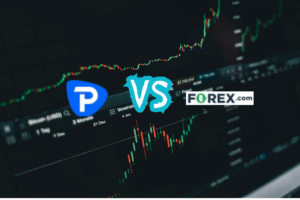
Since the beginning of this year, the value of the sterling has been falling against the United States dollar. Today, it reached a level that we have not seen in almost 37 years. The issue that traders and investors need to ask themselves is whether or not they should take advantage of this chance to purchase Sterling while it is now trading at its lowest level since 1985 or whether or not they should sell even more Sterling.
Broker Review Contents
Why Is Sterling Selling off
On Friday, the value of the pound fell to its lowest level since 1985. This came following a wave of data on UK retail sales that was poorer than anticipated, which increased worries that the nation is heading for a lengthy recession.
According to statistics provided by Refinitiv, the British pound fell by 0.8% during morning trading in London, reaching a price of $1.137. This marks the first time the currency has traded below $1.14 in nearly four decades.
This move was a reflection of the widespread strength of the dollar as well as special anxiety over the status of the economy in Britain. At a price of €1.142, the pound’s value versus the euro was down by around 0.4 percent, reaching a level not seen since the beginning of 2021.
According to data that was released on Friday by the Office for National Statistics, retail sales in the UK took a significant nosedive in the month of August as customers struggled to cope with rising prices and high energy expenses.
Between the months of July and August, the total number of goods purchased in the UK decreased by 1.6%, reversing the little increase that was seen in the previous month.
Reasons Behind The Sterling
To begin, consumers have been put in a difficult position as a direct result of the continuous problem around the cost of living. Their discretionary income has decreased as a result of rising costs associated with energy and rising inflation rates.
Second, the United Kingdom has certain problems that it has brought upon itself. Such as Brexit. Despite the fact that it took the United Kingdom many years to strike a deal with the European Union, the problems that surround Northern Ireland are still just as difficult to solve.
Thirdly, the United Kingdom has shifted its political attitude toward China. This has resulted in an escalation of the political tensions that exist between the two nations.
Fourthly, the Bank of England has already raised interest rates many times this year. Forex traders anticipate that the interest rate in the UK will climb all the way to 4% by the year 2023. Higher rates are slowing economic growth
Current State of the British Pound
Fast forward to late 2025, and the pound has staged a meaningful recovery from its crisis lows. GBP/USD currently trades around $1.35, representing a substantial rebound from the sub-$1.10 levels witnessed during the mini-budget turmoil. Against the euro, sterling has maintained relative stability, hovering in the 0.83-0.87 range throughout much of the year.
Several factors have contributed to this recovery. The Bank of England’s decisive monetary policy response, which saw interest rates rise to combat inflation, provided support for the currency. Political stability returned following the change in government, and fiscal policy has been placed on a more sustainable footing with the current administration’s focus on rebuilding credibility with markets.
However, the pound remains well below levels seen prior to the 2016 Brexit referendum, when GBP/USD traded comfortably above $1.40. This persistent discount reflects ongoing structural concerns about the UK economy’s growth trajectory and its trading relationships following departure from the European Union.
Bank of England Policy: The Key Near-Term Driver
The Bank of England’s monetary policy decisions represent the single most important near-term influence on sterling’s direction. In December 2025, the Monetary Policy Committee voted 5-4 to cut the Bank Rate by 25 basis points to 3.75%, marking the sixth reduction since August 2024 and bringing borrowing costs to their lowest level since late 2022.
This easing cycle reflects the central bank’s assessment that inflationary pressures have moderated sufficiently to warrant lower rates. UK inflation fell to 3.2% in November 2025, below the Bank’s own forecast of 3.4% and significantly lower than the peak of over 11% recorded in 2022. The MPC noted that “the risk from greater inflation persistence has become somewhat less pronounced,” providing scope for further policy accommodation.
Looking ahead to 2026, market expectations and analyst forecasts suggest the Bank Rate will continue its gradual descent. JP Morgan’s base case anticipates cuts in March and June 2026, bringing the rate down to 3.25%. Morgan Stanley economists project trims in February, April, and June on the back of declining inflationary pressures and rising unemployment. Goldman Sachs Research predicts quarterly cuts throughout 2026 until rates reach 3.25% by mid-year.
For the pound, the pace and extent of Bank of England easing relative to other major central banks will prove crucial. If the BoE cuts more aggressively than the Federal Reserve or European Central Bank, sterling could face downward pressure as interest rate differentials narrow unfavourably. Conversely, if UK rates remain relatively elevated due to persistent inflation concerns, the pound could find support.
Economic Fundamentals: Growth Challenges Persist
The UK economy faces significant headwinds that could weigh on sterling’s performance through 2026. GDP contracted for a second consecutive month in October 2025, while unemployment rose to 5.1%, its highest level since 2021. Private sector wage growth has cooled to its weakest pace since November 2020, suggesting softening labour market conditions.
Goldman Sachs economists forecast UK GDP growth of just 1.2% in 2025, below both the Bank of England’s projection of 1.5% and consensus estimates. Growth is expected to slow further in 2026 as the effects of fiscal consolidation and global trade uncertainties take hold.
The Office for Budget Responsibility’s assessment provides additional cause for caution. The fiscal watchdog calculates that the post-Brexit trading relationship will reduce long-run UK productivity by 4% relative to remaining in the EU, with effects accumulating gradually over 15 years. Recent academic research by economists at Stanford, Nottingham, and Cambridge universities suggests the impact may be even larger, estimating that UK GDP per capita was 6-8% lower by 2025 than it would have been without Brexit.
These structural growth challenges could limit sterling’s upside potential, even if monetary policy and short-term economic indicators prove supportive. Currencies of slower-growing economies typically underperform over extended periods, and the pound may struggle to sustain rallies without evidence of improving productivity and investment trends.
GBP/USD Forecast for 2026: What Analysts Expect
Currency forecasters present a moderately constructive outlook for GBP/USD heading into 2026, though projections vary considerably depending on assumptions about monetary policy, economic growth, and global risk sentiment.
Consensus forecasts compiled by leading financial institutions project GBP/USD reaching 1.3526 by year-end 2025, rising to 1.3638 by March 2026 and 1.3752 by year-end 2026. These projections imply gradual appreciation driven by a combination of dollar weakness and improving UK fundamentals.
Long-range forecasts offer a more detailed monthly breakdown, projecting GBP/USD at 1.368 in January 2026, fluctuating through the year before potentially reaching 1.481 by October 2026. However, such extended forecasts carry significant uncertainty and should be treated as indicative rather than precise predictions.
More conservative projections come from RBC Brewin Dolphin, which maintains a bearish stance forecasting GBP/USD at 1.30 in late 2025 to early 2026. Their analysis suggests much of the pound’s recent strength reflects underlying dollar weakness rather than genuine confidence in sterling.
Invesco takes a more optimistic view, predicting GBP/USD could reach 1.40 by mid-2026, driven by continued dollar depreciation alongside a slowing US economy and investor concerns about American fiscal and trade policies.
GBP/EUR Outlook: European Dynamics Matter
Against the euro, sterling’s prospects appear more mixed. The GBP/EUR exchange rate is forecast at approximately 1.13-1.14 through 2026, suggesting relative stability between the two currencies.
The eurozone economy has shown unexpected resilience, with the composite PMI reaching two-and-a-half-year highs in late 2025. This improved performance, combined with the European Central Bank’s own policy trajectory, limits the scope for significant sterling outperformance against the single currency.
Traders should note that GBP/EUR movements often reflect relative growth differentials between the UK and eurozone economies. Any acceleration in European activity or deterioration in UK conditions could push the cross rate lower, while the reverse scenario would support sterling appreciation.
Technical Analysis: Key Levels to Watch
From a technical perspective, GBP/USD has established important support and resistance levels that traders should monitor closely.
The 200-day simple moving average, currently around $1.34, serves as a key indicator of the medium-term trend. Prices trading consistently above this level suggest bullish momentum, while a sustained break below could signal a shift to bearish conditions.
On the upside, the $1.35 psychological level represents near-term resistance, with the 50% Fibonacci retracement of the September-November 2024 decline located around $1.3365. A break above $1.37 would open the path toward the psychologically significant $1.40 level.
Support lies at the $1.32 area, followed by the more critical $1.30 level. A decisive break below $1.30 would suggest renewed downside momentum and could target the November 2025 lows near $1.30.
Technical indicators currently show bullish signals, with oscillators holding in positive territory. However, traders should remain alert to potential reversals, particularly around key economic data releases and central bank policy announcements.
Should You Buy or Sell the Pound in 2026?
The decision to buy or sell sterling ultimately depends on individual circumstances, risk tolerance, and investment horizon. However, several considerations can help frame the analysis.
Arguments for Buying the Pound:
The Bank of England’s gradual approach to rate cuts suggests UK interest rates will remain relatively elevated compared to some peers, potentially supporting carry trade flows into sterling. Inflation has moderated significantly, reducing one source of economic uncertainty. Political stability has returned following the 2022 turmoil, and fiscal policy appears more credible. Technical indicators suggest bullish momentum in the near term.
Furthermore, consensus forecasts point to modest appreciation against the dollar through 2026, driven partly by expected dollar weakness as the Federal Reserve continues its own easing cycle. For those with US dollar exposure, converting to sterling at current levels could prove advantageous if these projections materialise.
Arguments for Selling the Pound:
Structural challenges facing the UK economy, including Brexit-related trade barriers and subdued productivity growth, could limit sterling’s upside potential over the medium term. The unemployment rate has risen to multi-year highs, and GDP growth remains anaemic. Academic research suggests the economic impact of Brexit continues to accumulate, with GDP potentially 6-8% lower than counterfactual scenarios.
The narrow 5-4 vote on the December 2025 rate decision highlights ongoing divisions within the MPC about the appropriate pace of easing. If inflation proves stickier than expected or wage growth reaccelerates, the Bank may be forced to slow or pause its cutting cycle, creating volatility in currency markets.
Global uncertainties, including potential changes in US trade policy and geopolitical tensions, add additional layers of risk. Sterling has historically been sensitive to shifts in global risk sentiment, tending to depreciate during periods of market stress.
Practical Considerations for Currency Decisions
For individuals and businesses making currency decisions, several practical factors deserve consideration beyond pure exchange rate forecasts.
Timing and Averaging: Rather than attempting to time the market perfectly, consider spreading currency conversions over multiple transactions. This approach reduces the risk of executing at unfavourable rates and smooths out short-term volatility.
Hedging Options: Businesses with ongoing currency exposure should explore hedging instruments such as forward contracts or options. While these carry costs, they provide certainty about future exchange rates and protect against adverse movements.
Transaction Costs: Pay attention to the spread between buying and selling rates offered by different providers. Banks typically offer less competitive rates than specialist currency brokers, and the difference can be substantial for larger transactions.
Economic Calendar: Be aware of key data releases and central bank meetings that could trigger currency volatility. Major events include monthly inflation reports, employment data, GDP releases, and Bank of England policy announcements.
Conclusion
The British pound’s journey from 37-year lows to current levels around $1.35 reflects the interplay of monetary policy, fiscal credibility, and economic fundamentals. Looking ahead to 2026, the currency faces both opportunities and challenges.
On the positive side, inflation has moderated significantly, the Bank of England is gradually reducing interest rates, and political stability has been restored. Consensus forecasts suggest modest appreciation against the dollar, supported by expected greenback weakness.
However, structural headwinds including Brexit-related trade barriers, subdued productivity growth, and rising unemployment create uncertainty about the UK’s medium-term economic trajectory. The pound may struggle to sustain significant rallies without clearer evidence of improving fundamentals.
For those considering currency decisions, the outlook suggests a cautiously constructive stance on sterling, with appropriate risk management given the inherent uncertainties. Whether buying or selling, staying informed about economic developments and central bank policy will prove essential for navigating the year ahead.
Conclusion
The chances of the Sterling making a U-turn are slim until and unless the United Kingdom finds a solution to its energy crisis, which is being driven once again by improper foreign policies, and takes on a political stance that is friendlier toward China.























